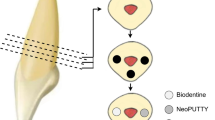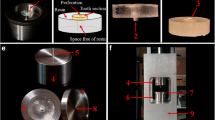Abstract
Objectives
The aim of this study was to compare the push-out bond strength of three calcium silicate cements to dentine after two different irrigation regimes.
Materials and methods
One hundred eighty 2-mm-thick root sections were prepared. The sections were divided into three main groups (n = 60). In group A, the sections were immersed in 1 % NaOCl for 3 min. In group B, the sections were immersed in 17 % EDTA for 3 min followed by 1 % NaOCl for the same period of time. In group C (control group), no irrigation was applied to the sections. The samples from each group were divided into four subgroups (n = 15). In subgroups A1, B1 and C1, DiaRoot BioAggregate; in subgroups A2, B2 and C2, MTA-Angelus and in subgroups A3, B3 and C3, MM-MTA were mixed with hand-mixing. In subgroups A4, B4 and C4, MM-MTA was mixed with auto-mixing. The mixed cements were then placed into cavities with a carrier. The samples were submitted to the push-out test and were loaded. All the data were analysed with one-way analysis of variance and the Tukey HSD multiple comparisons (p < 0.05).
Results
There were no statistically significant differences between the irrigation regimes regardless of the used materials. The resistance to displacement in subgroup B4 was significantly greater than that presented by subgroups A3, B3 and C3 (p < 0.05) while not different than all other groups.
Conclusions
Irrigation regimes had not affected the push-out bond strength of the calcium silicate cements. Also, strength of auto-mixed MM-MTA was similar to the other cements.
Clinical relevance
The novel calcium silicate cements would be a potentially useful material in endodontic procedures with favourable properties.

Similar content being viewed by others
References
Gancedo-Caravia L, Garcia-Barbero E (2006) Influence of humidity and setting time on the push-out strength of mineral trioxide aggregate obturations. J Endod 32:894–6
Parirokh M, Torabinejad M (2010) Mineral trioxide aggregate: a comprehensive literature review-Part I: chemical, physical, and antibacterial properties. J Endod 36:16–27
Shokouhinejad N, Nekoofar MH, Iravani A, Kharrazifard MJ, Dummer PM (2010) Effect of acidic environment on the push-out bond strength of mineral trioxide aggregate. J Endod 36:871–4
Hong ST, Bae KS, Baek SH, Kum KY, Shon WJ, Lee W (2010) Effects of root canal irrigants on the push-out strength and hydration behaviour of accelerated mineral trioxide aggregate in its early setting phase. J Endod 36:1995–9
Saghiri MA, Shokouhinejad N, Lotfi M, Aminsobhani M, Saghiri AM (2010) Push-out bond strength of mineral trioxide aggregate in the presence of alkaline pH. J Endod 36:1856–9
Shahi S, Rahimi S, Yavari HR, Samiei M, Janani M, Bahari M, Abdolrahimi M, Pakdel F, Aghbali A (2012) Effects of various mixing techniques on push-out bond strengths of white mineral trioxide aggregate. J Endod 38:501–4
Drummond JL, Sakaquchi RL, Racean DC, Wozny J, Steinberg AD (1996) Testing mode and surface treatment effects on dentin bonding. J Biomed Mat Res 32:533–41
Apaydin ES, Shabahang S, Torabinejad M (2004) Hard-tissue healing after application of fresh or set MTA as root-end-filling material. J Endod 30:21–4
Hakki SS, Bozkurt SB, Ozcopur B, Purali N, Belli S (2012) Periodontal ligament fibroblast response to root perforations restored with different materials—a laboratory study. Int Endod J 45:240–8
Hakki SS, Bozkurt SB, Hakki EE, Belli S (2009) Effects of mineral trioxide aggregate on cell survival gene expression associated with mineralized tissues and biomineralization of cementoblasts. J Endod 35:513–9
Karabucak B, Li D, Lim J, Iqbal M (2005) Vital pulp therapy with mineral trioxide aggregate. Dent Traumatol 21:240–3
Felippe WT, Felippe MCS, Rocha MJC (2006) The effect of mineral trioxide aggregate on the apexification and periapical healing of teeth with incomplete root formation. Int Endod J 39:2–9
Cehreli ZC, Isbitiren B, Sara S, Erbas G (2011) Regenerative endodontic treatment (revascularization) of immature necrotic molars medicated with calcium hydroxide: a case series. J Endod 37:1327–30
Bogen G, Kuttler S (2009) Mineral trioxide aggregate obturation: a review and case series. J Endod 35:777–90
Parirokh M, Torabinejad M (2010) Mineral trioxide aggregate: a comprehensive literature review—Part III: clinical pplications, drawbacks, and mechanism of action. J Endod 36:400–13
De-Deus G, Canabarro A, Alves G, Linhares A, Senne MI, Granjeiro JM (2009) Optimal cytocompatibility of a bioceramic nanoparticulate cement in primary human mesenchymal cells. J Endod 35:1387–90
Zhang H, Pappen G, Haapasalo M (2009) Dentin enhances the antibacterial effect of mineral trioxide aggregate and bioaggregate. J Endod 35:221–4
Reyes-Carmona JF, Felippe MS, Felippe WT (2010) The biomineralization ability of mineral trioxide aggregate and portland cement on dentin enhances the push-out strength. J Endod 36:286–91
Torabinejad M, Parirokh M (2010) Mineral trioxide aggregate: a comprehensive literature review—part II: leakage and biocompatibility investigations. J Endod 36:190–202
Kayahan MB, Nekoofar MH, Kazandağ M, Canpolat C, Malkondu O, Kaptan F, Dummer PM (2009) Effect of acid-etching procedure on selected physical properties of mineral trioxide aggregate. Int Endod J 42:1004–14
VanderWeele RA, Schwartz SA, Beeson TJ (2006) Effect of blood contamination on retention characteristics of MTA when mixed with different liquids. J Endod 32:421–4
Hashem AAR, Wanees Amin SA (2009) The effect of acidity on dislodgment resistance of mineral trioxide aggregate and bioaggregate in furcation perforations: an in vitro comparative study. J Endod 38:245–9
El-Ma'aita AM, Qualtrough AJE, Watts DC (2012) A Micro-computed tomography evaluation of mineral trioxide aggregate root canal fillings. J Endod 38:670–2
Aminoshariae A, Hartwell GR, Moon PC (2003) Placement of mineral trioxide aggregate using two different techniques. J Endod 29:679–82
Yeung P, Liewehr FR, Moon PC (2006) A quantitative comparison of the fill density of MTA produced by two placement techniques. J Endod 32:456–9
Namazikhah MS, Nekoofar MH, Sheykhrezae MS, Salariyeh S, Hayes SJ, Bryant ST, Mohammadi MM, Dummer PM (2008) The effect of pH on surface hardness and microstructure of mineral trioxide aggregate. Int Endod J 41:108–16
Nekoofar MH, Haddad DC, Nodle J, Aseeley Z (2009) Water content of ampoule packaged with ProRoot MTA. Int Endod J 42:205–10
Nekoofar MH, Aseeley Z, Dummer PM (2010) The effect of various mixing techniques on the surface microhardness of mineral trioxide aggregate. Int Endod J 43:312–20
Timpawat S, Vongsavan N, Messer HH (2001) Effect of removal of the smear layer on apical microleakage. J Endod 27:351–3
Meryon SD, Brook AM (1990) Penetration of dentine by three oral bacteria in vitro and their associated cytotoxicity. Int Endod J 23:196–202
Oksan T, Aktener BO, Sen BH, Tezel H (1993) The penetration of root canal sealers into dentinal tubules: a scanning electron microscope study. Int Endod J 26:301–5
Yan P, Peng B, Fan B, Fan M, Bian Z (2006) The effects of sodium hypochlorite (5.25%), chlorhexidine (2%), and glyde file prep on the bond strength of MTA-dentin. J Endod 32:58–60
Lee YL, Lin FH, Wang WH, Ritchie HH, Lan WH, Lin CP (2007) Effects of EDTA on the hydration mechanism of mineral trioxide aggregate. J Dent Res 86:534–8
Smith JB, Loushine RJ, Weller RN, Rueggeberg FA, Whitford GM, Pashley DH, Tay FR (2007) Metrologic evaluation of the surface of white MTA after the use of two endodontic irrigants. J Endod 33:463–7
Uyanik MO, Nagas E, Sahin C, Dagli F, Cehreli ZC (2009) Effects of different irrigation regimens on the sealing properties of repaired furcal perforations. Oral Surg Oral Med Oral Pathol Oral Radiol Endod 107:e91–5
Yildirim T, Oruçoğlu H, Cobankara FK (2008) Long-term evaluation of the influence of smear layer on the apical sealing ability of MTA. J Endod 34:1537–40
Conflict of interest
The authors deny any conflicts of interest
Author information
Authors and Affiliations
Corresponding author
Rights and permissions
About this article
Cite this article
Çelik, D., Er, K., Serper, A. et al. Push-out bond strength of three calcium silicate cements to root canal dentine after two different irrigation regimes. Clin Oral Invest 18, 1141–1146 (2014). https://doi.org/10.1007/s00784-013-1082-4
Received:
Accepted:
Published:
Issue Date:
DOI: https://doi.org/10.1007/s00784-013-1082-4




